It circled the Earth four times in every direction and shattered the ears of sailors 40 miles away. The Krakatoa volcano erupted with ungodly strength, sending ripples of sound heard thousands of miles away.
The Krakatoa eruption was possibly the loudest sound ever experienced by human ears. But a few other freak events give Krakatoa a run for its money. The Tunguska Event, for instance, flattened approximately 80,000 trees, shattering windows dozens of kilometers away.
It’s not easy to tell which is the loudest sound ever experienced by humans, but we’ve narrowed it down to a few — and with some careful calculations, we might have a winner.
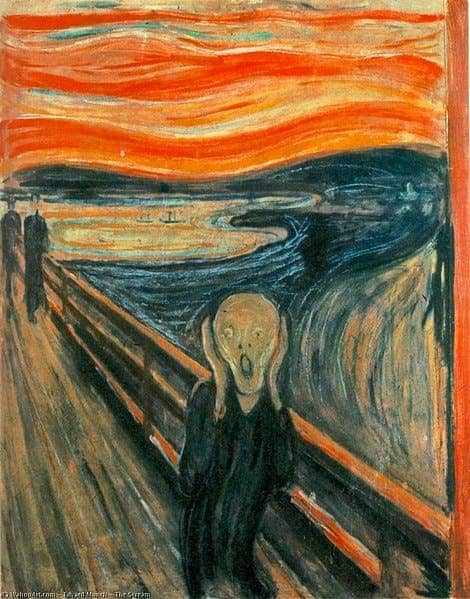
Loud sounds
Sounds are essentially vibration — a vibration produced by a source and sent through a medium such as air or water. Sounds waves (or acoustic waves) can also propagate through the ground. Seismic waves are, essentially, a type of acoustic waves.
Our bodies pick up sound waves through our ear canal and to the eardrum, where they are transformed into vibrations. These vibrations are then transformed into electrical signals which our brain can understand. Humans generally hear sounds at frequencies between 20 to 20,000 Hz. We can also perceive sounds outside of that interval, but we generally feel rather than hear them.

The intensity of the sound is typically measured in decibels. The decibel (dB) is essentially a unit of measure for sound pressure level in air. The reference pressure for sound in air is important — for instance, decibels in air and decibels in water don’t mean the same thing. For now, however, we’ll limit the discussion to decibels in air, which is set around the typical perception threshold of a human.
In theory, sounds of 1 dB or several dB are audible. But in real life, it’s never really quiet. If you were to stand in an extremely quiet room (and these have been built), you would easily hear your heartbeat. You might even hear your lungs or your stomach.
In reality, there’s always some ambient background noise. Our breathing is at about 10 dB. Passing cars, wind, and electronics also produce a few dB. A whisper comes in at about 20 dB, and a normal conversation at around 60 dB.
We start to experience acute pain at 125 decibels, or even below that. According to the National Institute for Occupational Safety and Health, the maximum exposure time at 85 dBA is eight hours. At 110 dBA, the maximum exposure time is one minute and 29 seconds. If you’re exposed to 140 decibels for even seconds, you can suffer irreversible ear damage. This is some serious strength already.

Here are a few sound levels for reference:
- rainfall: 50 dB;
- noisy restaurant: 70 dB;
- loud-ish music on speakers: 80 dB;
- electric drill: 95 dB;
- football game: 115 dB;
- thunder: 120 dB;
- shotgun: 140 dB.
It’s also important to note that acoustic decibels aren’t a linear scale. Something that has 100 dB isn’t two times louder than something at 50 dB — it’s much, much louder. That’s because decibels are essentially a logarithmic scale — when something is 10 dB higher, it is 10 times louder. When something is 20 dB higher, it is 100 times louder. When something is 60 dB higher, it is a whopping 1,000,000 times higher. However, the way we perceive sounds also isn’t linear. A 10 dB increase is perceived by people as sounding roughly twice as loud.
Now that we know all that, let’s look at the loudest sounds — both man-made and natural.
A note on the loudest possible sound in air
Strictly speaking, the loudest possible sound in air, is 194 dB. The “loudness” of the sound is dictated by how large the amplitude of the waves is compared to ambient air pressure. A sound of 194 dB has a pressure deviation of 101.325 kPa, which is ambient pressure at sea level, at 0 degrees Celsius (32 Fahrenheit). Essentially, at 194 dB, the waves are creating a complete vacuum between themselves.
You can go louder than 194 dB, but that’s not technically a “sound” anymore. The extra energy starts distorting the entire wave, and you end up with something that’s more a shockwave and less a soundwave. At that level, sounds don’t pass through air — they push the air along, producing pressurized burst (shockwaves).
But for the sake of the argument (and because let’s face it, no one wants to be overly pedantic), we will consider anything over 194 dB as sounds — just know that that’s not an exact phrasing.
The loudest band, the loudest sound?
Concerts are a good place to start when we’re looking for really loud sounds.
Several bands claim the distinction of being the loudest in the world, with some claiming to be “Louder than Hell” — yes, I’m looking at you, heavy metal fans.
The fight to become the loudest band is a storied one, and not without controversies. The first true contender is the band Deep Purple, whose 1972 London concert was included in the Guinness Book of World Records as the loudest ever recorded at the time, with 117 dB. Several members of the audience fell unconscious, and Guinness started being very skeptical of this particular record, as it could lead to serious hearing damage and loss of consciousness.
The American band Manowar claims several concerts going over 120 dB, including one remarkable 139 dB during the soundcheck (not the actual performance) at the Magic Circle Fest in 2008. The band Kiss was also recorded to hit 136 dB at a concert in Ottawa. The concert was so loud that several complaints were made, forcing the band to turn the volume down a bit.
But as remarkably loud as these bands can get, they can lay no claim to the “loudest sound title”.
Moving on!
The Loudest Plane? Shuttle?
Planes are one of mankind’s most remarkable technical achievements, fulfilling a dream which has probably been around since the dawn of time: flying. But as anyone who’s even been on or near a plane can attest — they can get very, very loud.
All planes are loud, but some are louder than others. Despite its relatively low size, the Republic XF-84H “Thunderscreech” is widely regarded to be the loudest plane ever recorded.
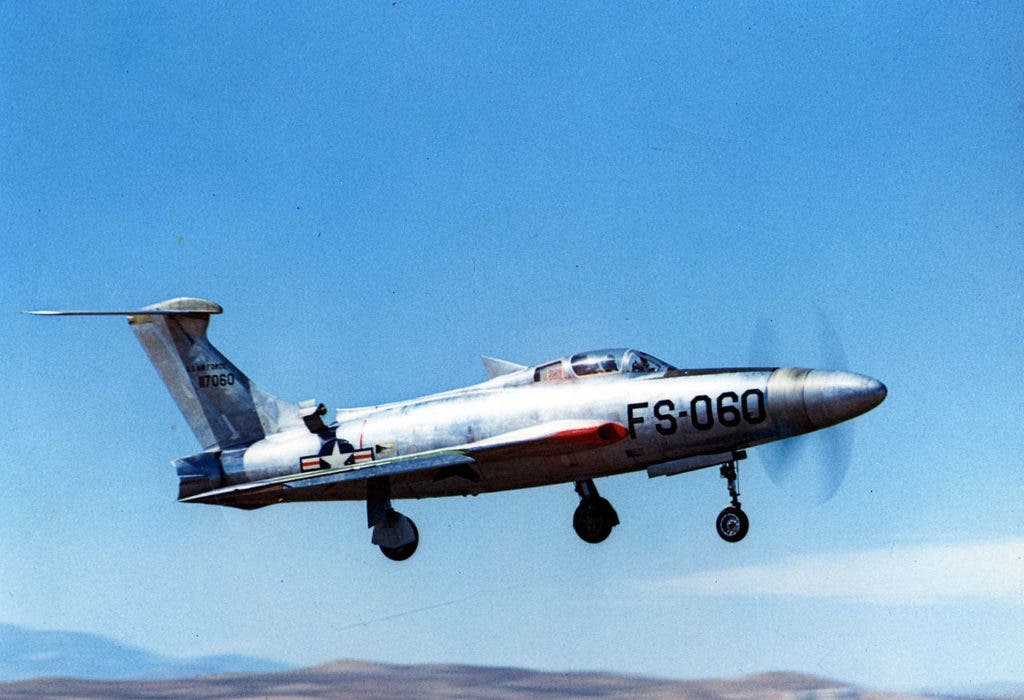
The plane was so loud it could reportedly be heard from over 25 miles (40 km) away. It was so loud that it was dangerous for anyone to be around it, and the round crew suffered repeatedly from this.
The XF-84H was a propeller plane, but unlike standard propellers which turn at subsonic speed, the very tip of its blade moved at supersonic speeds. The XF-84H was an outlier in many regards and never made it past prototype stage, but it went down in history as the loudest plane.
This created a continuous sonic boom powerful enough to knock a man down: an unfortunate crew member was severely incapacitated during a ground run by this phenomenon. Coupled with its considerable subsonic noise, the aircraft was notorious for inducing severe nausea and headaches due to its noise. The sound shockwaves even induced seizures in an engineer after a close-range inspection.
It’s not clear just how loud this plane was, but unofficial estimates put it around 140 dB.
But if we consider shuttles in this category, they’ve been shown to produce far stronger sounds than even the XF-84H.
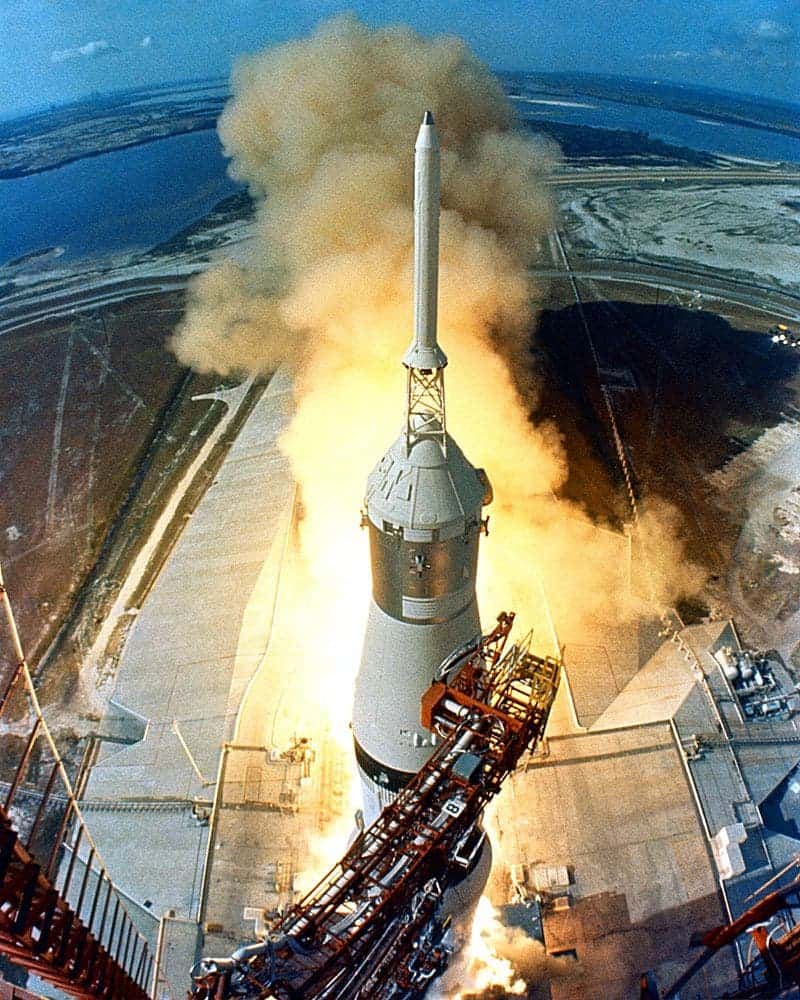
A NASA report writes that the launch of Saturn V, a rocket designed to send people to the Moon, produced sounds of up to 204 dB. This particular rocket had engines that generated a cumulative 7.5 million pounds of thrust — an absolute monster.
Saturn V was pivotal in the Apollo program, and in the deployment of Skylab — the precursory to the International Space Station. This made for what was probably the loudest sound ever heard at NASA, and the loudest ever produced by mankind, with one exception.
Bombs.
The loudest Bomb
Bombs are, through their very nature, loud. They’re meant to destroy things, and they produce a lot of energy, which manifests into sound. But while all bombs are loud, some are definitely louder than others.
As you’d expect, the military isn’t particularly keen on sharing details about bomb testing, so most such values come from estimates. The infamous bombs of Hiroshima and Nagasaki, for instance, are estimated to have produced sounds of over 170 decibels and were heard over 100 km away.
But, as if to prove its destructive potential, mankind has developed bombs far stronger than the ones in Hiroshima and Nagasaki. Let’s skip the unfortunate history of nuclear bomb development and jump to the strongest such bomb ever developed: the Tsar Bomb.
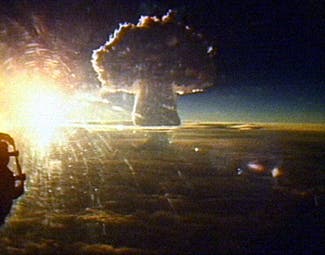
The Soviet RDS-202 hydrogen bomb (code name Ivan or Vanya) became known to the rest of the world as the Tsar Bomba. Tested in 1961, the bomb was 8 m (26 ft) long and weighed 27,000 kg (60,000 pounds). Its explosion equaled 50 megatons of TNT, and ripples from its test explosion could be felt all around the world. The Hiroshima and Nagasaki bombs destroyed cities in an instant — well, the Tsar bomb was 3,300 times stronger than that.
As the bomb with the most energy, it also probably produced the strongest sound — not only by a bomb, but ever produced by mankind. Again, this is based on some calculation, but the most reliable figure seems to be 224 dB — a shocking figure.
Keep in mind that decibels are logarithmic. In other words, 224 dB is 100 times louder than the 204 dB from the Saturn V rocket. Not only would the sound alone kill you, but it’s almost impossible to imagine just how strong that sound is.
But as gargantuan as that is, it’s a mere fraction of what nature can produce. No, even bombs didn’t produce the loudest sound in the world.
Tunguska vs Krakatoa
… and then there were two.
It’s hard to imagine just how strong the Tunguska explosion was. An object (probably fallen off of an asteroid or a comet) entered Earth’s atmosphere in June 1908, with such speed that it combusted and exploded 5 to 10 kilometers (3 to 6 miles) above the ground, over an unpopulated area.
We’re lucky it did.
The explosion was strong enough to destroy an entire metropolitan area, flattening an estimated 80 million trees over an area of 2,150 square km (830 sq mi).
People as far as 20 km were knocked off their feet, windows were shattered, and witnesses report unbearable sounds and heat. Here is a witness account from Russian geologist Leonid Kulik, who was 65 km (40 mi) away:
“The split in the sky grew larger, and the entire northern side was covered with fire. At that moment I became so hot that I couldn’t bear it as if my shirt was on fire; from the northern side, where the fire was, came strong heat. I wanted to tear off my shirt and throw it down, but then the sky shut closed, and a strong thump sounded, and I was thrown a few metres. I lost my senses for a moment, but then my wife ran out and led me to the house.”
“After that such noise came, as if rocks were falling or cannons were firing, the Earth shook, and when I was on the ground, I pressed my head down, fearing rocks would smash it. When the sky opened up, hot wind raced between the houses, like from cannons, which left traces in the ground like pathways, and it damaged some crops. Later we saw that many windows were shattered, and in the barn, a part of the iron lock snapped.”
Over 1,000 scientific papers have been published on the Tunguska event, but it’s impossible to know just how strong the sound was — it’s quite likely that the Tunguska event could have reached 300 dB.
This could almost certainly be the loudest sound ever experienced by mankind if it were not for another event.
Krakatoa — probably the loudest “sound”
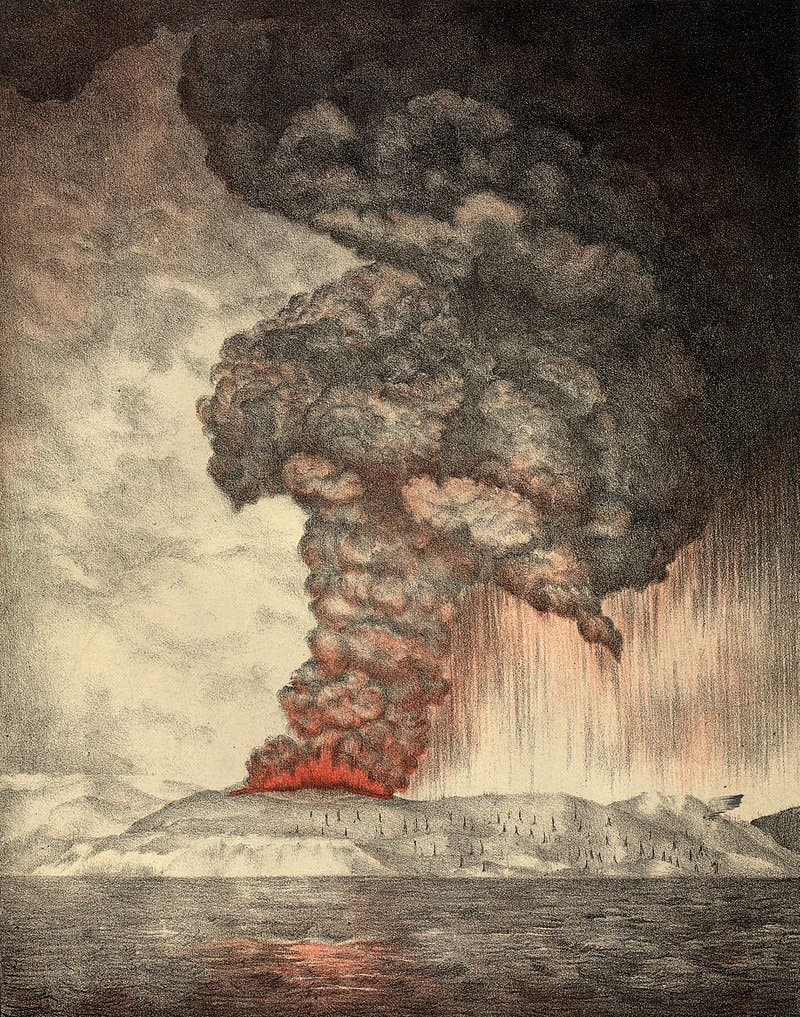
There are many stories about Krakatoa, all of them from people far away from the volcano — because no one really close to it could have survived. When Krakatoa erupted in 1883, it exploded with such force that it basically destroyed its island and atoll, releasing 20 million tons of sulfur into the atmosphere and shrouding the entire planet in aerosols that reduced global temperatures for years.
Artists were inspired, as Krakatoa produced spectacular sunsets across the world, inspiring painters to produce thousands of paintings of these sunsets. But Krakatoa’s eruption brought, above all else, destruction.

Over 30,000 people were killed by the volcano and the tsunamis it triggered. The sound ripples were also ungodly. It was a sheer disaster on the scale of which few events have hit the planet.
Some 2,100 km (1,300 miles) away, in the Andaman and Nicobar islands, people reported “extraordinarily loud sounds, as of guns firing”; 3,110 km (1,930 mi) away in Perth, Western Australia, people reported hearing what they thought to be artillery in the distance. As far as 4,800 km (3,000 mi) away, people heard the sound. Think about it this way: it’s as if someone made a sound in New York and people heard it all the way in Ireland, across the ocean.
The captain of a British ship called Norham Castle wrote a haunting report of Krakatoa’s eruption. The ship was 64 km (40 mi) from Krakatoa, and yet he wrote:
“So violent are the explosions that the ear-drums of over half my crew have been shattered. My last thoughts are with my dear wife. I am convinced that the Day of Judgement has come.”
Coincidentally, measuring instruments 160 km (100 mi) away from Krakatoa picked up sounds from the explosion: a whopping 172 decibels, incredibly loud considering the distance. Hundreds of kilometers away, the sounds were louder than the loudest concert ever recorded.
The air shockwave from Krakatoa (because you can’t really call it a sound) circled the globe 3-4 times in all directions. Tidal stations as far away as England and the US recorded a rise in ocean waves caused by this air pulse — an effect that had never been seen before.
Even as the sound could not be detected, the air wave made its presence felt. To this day, this event is called “the great air-wave”.
It’s estimated that the Krakatoa eruption reached 310 dB — a testament to the destructive force that nature can unleash.
There have almost certainly been even stronger eruptions in Earth’s history, but it’s impossible to say just how loud they were. The Krakatoa eruption is probably the loudest sound mankind has ever witnessed — and if we’re lucky, we won’t hear a louder one anytime soon.


